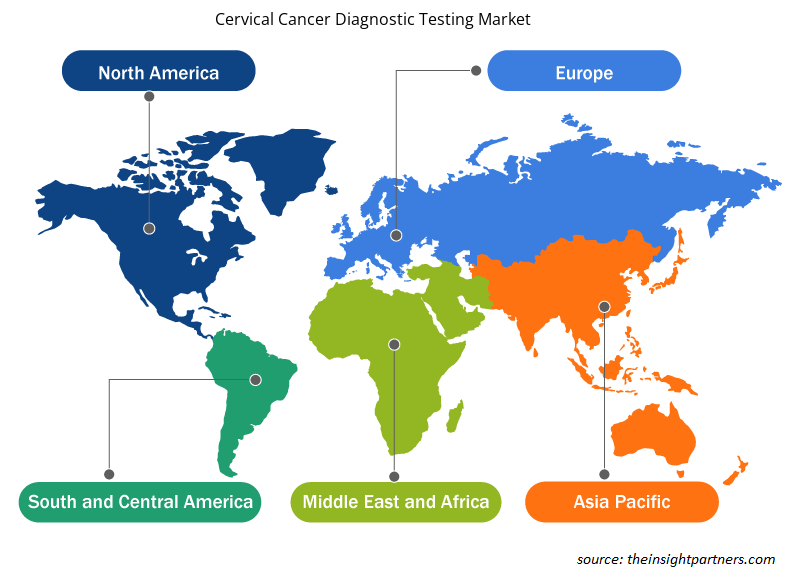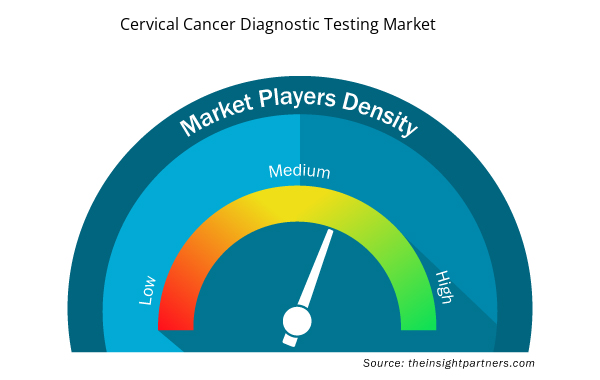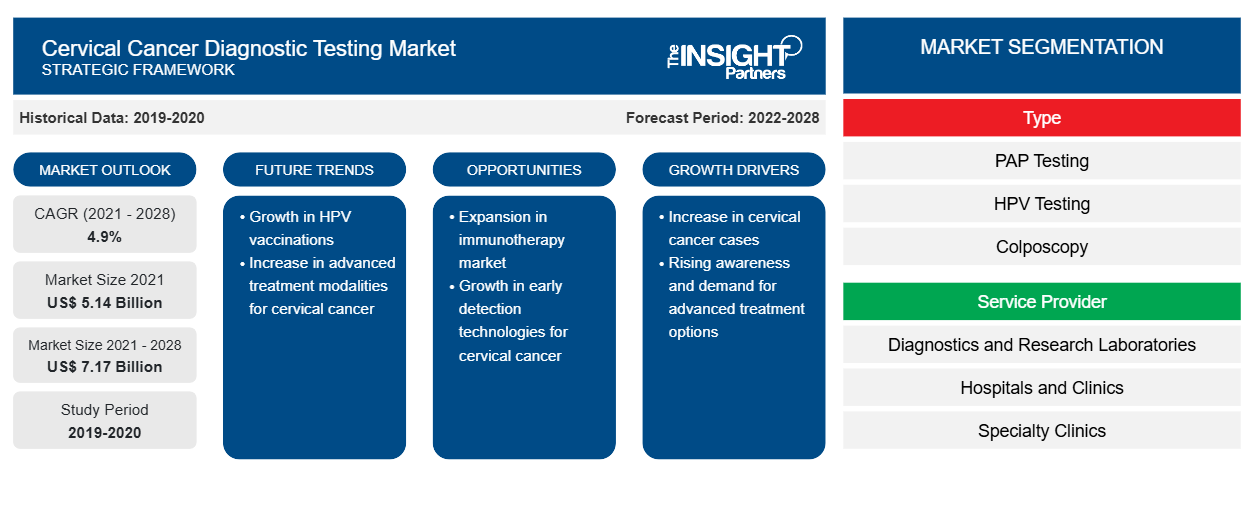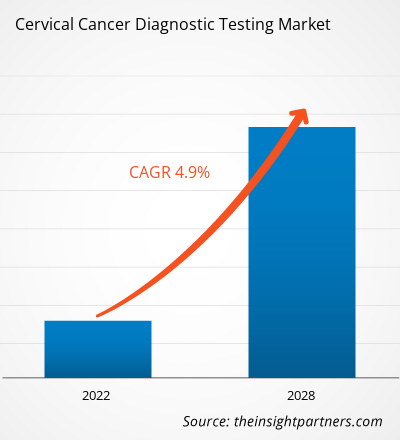宫颈癌诊断检测市场规模预计将从 2021 年的 51.4125 亿美元增至 2028 年的 71.6592 亿美元;预计 2021 年至 2028 年的复合年增长率为 4.9%。
宫颈癌死亡率很高(几乎 50%),但通过早期发现和预防可以降低死亡率。癌前病变为预防和治疗提供了机会,因为疾病进展通常会延迟。然而,由于缺乏认识或无法获得诊断服务,许多病例是在疾病进展的后期才被发现的。人乳头瘤病毒 (HPV) 是宫颈癌的主要原因,通常通过性接触传播。HPV 菌株有 100 多种,其中 13 种是高风险或致癌的。活性基因 - E6 或 E7 - 决定了 HPV 菌株是高风险还是低风险。E6 与 p53 结合,导致蛋白水解破坏。另一方面,E7 与视网膜母细胞瘤结合;这种结合取代了先前附着的转录因子,导致细胞周期停止,细胞凋亡调节受到抑制。HPV 测试可检测宫颈细胞中的人乳头瘤病毒。发展中国家资源匮乏地区采用的其他筛查方法是 HPV DNA 检测和目视检查。定期进行宫颈筛查有助于早期发现宫颈癌,从而降低该疾病的死亡率。每三年,建议所有 21 至 65 岁的女性进行一次巴氏涂片检查,建议 30 至 65 岁的女性同时进行巴氏涂片和 HPV 检测。就收入而言,这种类型在 2021 年占据了宫颈癌筛查市场的主导地位,预计在预测期内将继续占据主导地位。
定制此报告以满足您的需求
您可以免费定制任何报告,包括本报告的部分内容、国家级分析、Excel 数据包,以及为初创企业和大学提供优惠和折扣
- 获取此报告的关键市场趋势。这个免费样品将包括数据分析,从市场趋势到估计和预测。
市场洞察
预测期内癌症患病率上升推动宫颈癌诊断检测市场增长
癌症已成为全球死亡的主要原因。根据世界卫生组织 (WHO) 的数据,2019 年,癌症是 183 个国家 70 岁以下人群的第一大死亡原因,也是 123 个国家的第四大死亡原因。此外,根据世卫组织 2021 年 3 月发布的数据,2020 年因不同类型癌症死亡的人数约为 1000 万人。全球女性宫颈癌发病率的上升推动了宫颈癌诊断检测市场的增长。据世卫组织统计,每年有超过 270,000 名女性死于宫颈癌。由于疾病诊断较晚,低收入国家的宫颈癌死亡率更高。由于越来越多的人接受宫颈癌诊断测试来早期发现疾病,预计未来几年市场将增长。
癌症患病率的上升给全世界的医疗保健系统带来了负担。根据国际癌症研究机构 (IARC) 的数据,到 2040 年,全球新发癌症病例预计将达到约 2750 万,到 2040 年,癌症可能导致约 1.63 亿人死亡。生活方式的改变、吸烟、体力活动减少以及不确定的健康和气候条件等因素将在未来几年导致世界癌症负担进一步加重。
基于类型的洞察
根据类型,宫颈癌诊断检测市场细分为 PAP 检测、HPV 检测、阴道镜检查、宫颈活检、膀胱镜检查等。2021 年,PAP 检测占据了最大的市场份额,预计在 2021-2028 年期间将实现最高的复合年增长率。
基于服务提供商的见解
根据服务提供商,市场细分为研究、诊断和研究实验室、医院和诊所、专科诊所和家庭护理服务。2021 年,诊断和研究实验室部门占据了最大的市场份额,预计在 2021-2028 年期间将实现最高的复合年增长率。
在宫颈癌诊断检测市场运营的公司正在采用各种策略,例如产品创新,以满足全球不断变化的客户需求并在全球市场上保持其品牌名称。
宫颈癌诊断检测市场——细分
宫颈癌诊断检测市场根据类型和服务提供商进行细分。根据类型,市场细分为 PAP 检测、HPV 检测、阴道镜检查、宫颈活检、膀胱镜检查等。根据服务提供商,市场进一步细分为诊断和研究实验室、医院和诊所、专科诊所和家庭护理服务。在地理
方面,宫颈癌诊断检测市场细分为北美(美国、加拿大和墨西哥)、欧洲(法国、德国、意大利、英国、西班牙和欧洲其他地区)、亚太地区(澳大利亚、中国、印度、日本、韩国和亚太地区其他地区)、中东和非洲(沙特阿拉伯、南非、阿联酋和 MEA 其他地区)以及南美洲和中美洲(巴西、阿根廷和 SCAM 其他地区)。
宫颈癌诊断检测市场区域洞察
Insight Partners 的分析师已详细解释了预测期内影响宫颈癌诊断检测市场的区域趋势和因素。本节还讨论了北美、欧洲、亚太地区、中东和非洲以及南美和中美洲的宫颈癌诊断检测市场细分和地理位置。

- 获取宫颈癌诊断检测市场的区域特定数据
宫颈癌诊断检测市场报告范围
| 报告属性 | 细节 |
|---|---|
| 2021 年市场规模 | 51.4 亿美元 |
| 2028 年市场规模 | 71.7亿美元 |
| 全球复合年增长率(2021 - 2028) | 4.9% |
| 史料 | 2019-2020 |
| 预测期 | 2022-2028 |
| 涵盖的领域 | 按类型
|
| 覆盖地区和国家 | 北美
|
| 市场领导者和主要公司简介 |
|
宫颈癌诊断检测市场参与者密度:了解其对业务动态的影响
宫颈癌诊断检测市场正在快速增长,这得益于终端用户需求的不断增长,而这些需求又源于消费者偏好的不断变化、技术进步以及对产品优势的认识不断提高等因素。随着需求的增加,企业正在扩大其产品范围,进行创新以满足消费者的需求,并利用新兴趋势,从而进一步推动市场增长。
市场参与者密度是指在特定市场或行业内运营的企业或公司的分布情况。它表明在给定市场空间中,相对于其规模或总市场价值,有多少竞争对手(市场参与者)存在。
在宫颈癌诊断检测市场运营的主要公司有:
- F.霍夫曼-拉罗氏有限公司
- 雅培
- Quest Diagnostics 公司
- 凯杰公司
- Hologic 公司
免责声明:上面列出的公司没有按照任何特定顺序排列。

- 了解宫颈癌诊断检测市场的主要参与者概况
公司简介
- F.霍夫曼-罗氏有限公司
- 雅培
- Quest Diagnostics 公司
- 凯杰公司
- Hologic 公司
- DYSIS 医疗公司
- Femasys 公司
- Guided Therapeutics, Inc.
- 库珀集团
- 屋宇署
- 历史分析(2 年)、基准年、预测(7 年)及复合年增长率
- PEST 和 SWOT 分析
- 市场规模价值/数量 - 全球、区域、国家
- 行业和竞争格局
- Excel 数据集



Report Coverage
Revenue forecast, Company Analysis, Industry landscape, Growth factors, and Trends

Segment Covered
This text is related
to segments covered.

Regional Scope
North America, Europe, Asia Pacific, Middle East & Africa, South & Central America

Country Scope
This text is related
to country scope.
常见问题
Asia Pacific is registered as the fastest-growing region in the global cervical cancer diagnostic testing market. The market is this region is expected to grow significantly in countries such as China, Japan, and India. The market is driven by the increasing prevalence of cervical cancer in developing countries, including China, India, Malaysia, Japan, South Korea, and Australia.
The cervical cancer diagnostic testing market based on type is segmented into PAP testing, HPV testing, colposcopy, cervical biopsies, cystoscopy, others. In 2021, the PAP Testing segment accounted for the highest share. Besides, the HPV testing segment is expected to grow at a CAGR of 5.5% in the forecast period.
The global cervical cancer diagnostic testing market is segmented into North America, Europe, Asia Pacific, Middle East & Africa, and South & Central America. The North American area holds the largest market for aesthetic skin devices. The United States held the most significant cervical cancer diagnostic testing market and is expected to grow due to factors such as high awareness about disease prevention among women in the region, as well as to the many initiatives launched to prevent cervical cancer, which have increased the reach of insurance coverage for cervical screening tests, especially for low-income women, and others.
The cervical cancer diagnostic testing market majorly consists of the players such as as F. Hoffmann-La Roche Ltd., Abbott, Quest Diagnostics Incorporated, QIAGEN, Hologic, Inc., DYSIS Medical Inc., Femasys Inc., Guided Therapeutics, Inc, Cooper Companies, Inc., BD are amongst others.
Cervical Cancer refers to cancer that occurs in the cells of the cervix i.e. the lower part of the uterus that connects to the vagina. In 90% of the cases, cervical malignancies occur due to the HPV infection and are diagnosed through smear screening.
The factors that are driving and restraining factors that will affect the cervical cancer diagnostic testing market in the coming years. Factors such as the increasing prevalence of cancer and the rise in HPV infections are driving the market growth. However, less number of commercially available vaccines for the treatment of cancer are likely to hamper the growth of the market.
Trends and growth analysis reports related to Life Sciences : READ MORE..
The List of Companies - Cervical Cancer Diagnostic Testing Market
- F. HOFFMANN-LA ROCHE LTD.
- Abbott
- Quest Diagnostics Incorporated
- QIAGEN
- Hologic, Inc.
- DYSIS Medical Inc
- Femasys Inc.
- GUIDED THERAPEUTICS, INC
- Cooper Companies, Inc.
- BD
The Insight Partners performs research in 4 major stages: Data Collection & Secondary Research, Primary Research, Data Analysis and Data Triangulation & Final Review.
- Data Collection and Secondary Research:
As a market research and consulting firm operating from a decade, we have published and advised several client across the globe. First step for any study will start with an assessment of currently available data and insights from existing reports. Further, historical and current market information is collected from Investor Presentations, Annual Reports, SEC Filings, etc., and other information related to company’s performance and market positioning are gathered from Paid Databases (Factiva, Hoovers, and Reuters) and various other publications available in public domain.
Several associations trade associates, technical forums, institutes, societies and organization are accessed to gain technical as well as market related insights through their publications such as research papers, blogs and press releases related to the studies are referred to get cues about the market. Further, white papers, journals, magazines, and other news articles published in last 3 years are scrutinized and analyzed to understand the current market trends.
- Primary Research:
The primarily interview analysis comprise of data obtained from industry participants interview and answers to survey questions gathered by in-house primary team.
For primary research, interviews are conducted with industry experts/CEOs/Marketing Managers/VPs/Subject Matter Experts from both demand and supply side to get a 360-degree view of the market. The primary team conducts several interviews based on the complexity of the markets to understand the various market trends and dynamics which makes research more credible and precise.
A typical research interview fulfils the following functions:
- Provides first-hand information on the market size, market trends, growth trends, competitive landscape, and outlook
- Validates and strengthens in-house secondary research findings
- Develops the analysis team’s expertise and market understanding
Primary research involves email interactions and telephone interviews for each market, category, segment, and sub-segment across geographies. The participants who typically take part in such a process include, but are not limited to:
- Industry participants: VPs, business development managers, market intelligence managers and national sales managers
- Outside experts: Valuation experts, research analysts and key opinion leaders specializing in the electronics and semiconductor industry.
Below is the breakup of our primary respondents by company, designation, and region:

Once we receive the confirmation from primary research sources or primary respondents, we finalize the base year market estimation and forecast the data as per the macroeconomic and microeconomic factors assessed during data collection.
- Data Analysis:
Once data is validated through both secondary as well as primary respondents, we finalize the market estimations by hypothesis formulation and factor analysis at regional and country level.
- Macro-Economic Factor Analysis:
We analyse macroeconomic indicators such the gross domestic product (GDP), increase in the demand for goods and services across industries, technological advancement, regional economic growth, governmental policies, the influence of COVID-19, PEST analysis, and other aspects. This analysis aids in setting benchmarks for various nations/regions and approximating market splits. Additionally, the general trend of the aforementioned components aid in determining the market's development possibilities.
- Country Level Data:
Various factors that are especially aligned to the country are taken into account to determine the market size for a certain area and country, including the presence of vendors, such as headquarters and offices, the country's GDP, demand patterns, and industry growth. To comprehend the market dynamics for the nation, a number of growth variables, inhibitors, application areas, and current market trends are researched. The aforementioned elements aid in determining the country's overall market's growth potential.
- Company Profile:
The “Table of Contents” is formulated by listing and analyzing more than 25 - 30 companies operating in the market ecosystem across geographies. However, we profile only 10 companies as a standard practice in our syndicate reports. These 10 companies comprise leading, emerging, and regional players. Nonetheless, our analysis is not restricted to the 10 listed companies, we also analyze other companies present in the market to develop a holistic view and understand the prevailing trends. The “Company Profiles” section in the report covers key facts, business description, products & services, financial information, SWOT analysis, and key developments. The financial information presented is extracted from the annual reports and official documents of the publicly listed companies. Upon collecting the information for the sections of respective companies, we verify them via various primary sources and then compile the data in respective company profiles. The company level information helps us in deriving the base number as well as in forecasting the market size.
- Developing Base Number:
Aggregation of sales statistics (2020-2022) and macro-economic factor, and other secondary and primary research insights are utilized to arrive at base number and related market shares for 2022. The data gaps are identified in this step and relevant market data is analyzed, collected from paid primary interviews or databases. On finalizing the base year market size, forecasts are developed on the basis of macro-economic, industry and market growth factors and company level analysis.
- Data Triangulation and Final Review:
The market findings and base year market size calculations are validated from supply as well as demand side. Demand side validations are based on macro-economic factor analysis and benchmarks for respective regions and countries. In case of supply side validations, revenues of major companies are estimated (in case not available) based on industry benchmark, approximate number of employees, product portfolio, and primary interviews revenues are gathered. Further revenue from target product/service segment is assessed to avoid overshooting of market statistics. In case of heavy deviations between supply and demand side values, all thes steps are repeated to achieve synchronization.
We follow an iterative model, wherein we share our research findings with Subject Matter Experts (SME’s) and Key Opinion Leaders (KOLs) until consensus view of the market is not formulated – this model negates any drastic deviation in the opinions of experts. Only validated and universally acceptable research findings are quoted in our reports.
We have important check points that we use to validate our research findings – which we call – data triangulation, where we validate the information, we generate from secondary sources with primary interviews and then we re-validate with our internal data bases and Subject matter experts. This comprehensive model enables us to deliver high quality, reliable data in shortest possible time.


 获取此报告的免费样本
获取此报告的免费样本